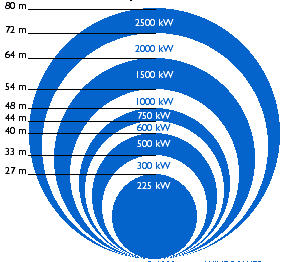Difference between revisions of "Wind Turbine Tower Size"
From DolceraWiki
Crazypaddu (Talk | contribs) |
Crazypaddu (Talk | contribs) |
||
| Line 23: | Line 23: | ||
<br> | <br> | ||
| − | {|border="2" cellspacing="0" cellpadding="1" width=" | + | {|border="2" cellspacing="0" cellpadding="1" width="25%" |
| style="background-color:#999990;padding:0.079cm;"| <center>[http://dolcera.com/wiki/index.php?title=Different_Types_and_Parts_of_a_Horizontal_Axis_Wind_Turbines <<Back to Different Types and Parts of a Horizontal Axis Wind Turbines Page]</center> | | style="background-color:#999990;padding:0.079cm;"| <center>[http://dolcera.com/wiki/index.php?title=Different_Types_and_Parts_of_a_Horizontal_Axis_Wind_Turbines <<Back to Different Types and Parts of a Horizontal Axis Wind Turbines Page]</center> | ||
|} | |} | ||
Latest revision as of 01:29, 10 March 2011
Size of Wind Turbines:
- Power Output Increases with the Swept Rotor Area
The area of the disc covered by the rotor, (and wind speeds, of course), determines how much energy can be obtained from the turbine. The picture gives an idea of the normal rotor sizes of wind turbines: A typical turbine with a 600 kW electrical generator will typically have a rotor diameter of some 44 meters (144 ft.). If the rotor diameter doubles, we get an area which is four times larger (two squared). This means that power output from the rotor also increase four times. Rotor diameters may vary somewhat from the figures given above, because many manufacturers optimise their machines to local wind conditions.
- Reasons for Choosing Large Turbines
- There are economies of scale in wind turbines, i.e. larger machines are usually able to deliver electricity at a lower cost than smaller machines. The reason is that the cost of foundations, road building, electrical grid connection, plus a number of components in the turbine (the electronic control system etc.), are somewhat independent of the size of the machine.
- Larger machines are particularly well suited for offshore wind power. The cost of foundations does not rise in proportion to the size of the machine, and maintenance costs are largely independent of the size of the machine.
- In areas where it is difficult to find sites for more than a single turbine, a large turbine with a tall tower uses the existing wind resource more efficiently.
- There are economies of scale in wind turbines, i.e. larger machines are usually able to deliver electricity at a lower cost than smaller machines. The reason is that the cost of foundations, road building, electrical grid connection, plus a number of components in the turbine (the electronic control system etc.), are somewhat independent of the size of the machine.
- Reasons for Choosing Smaller Turbines
- The local electrical grid may be too weak to handle the electricity output from a large machine. This may be the case in remote parts of the electrical grid with low population density and little electricity consumption in the area.
- There is less fluctuation in the electricity output from a wind park consisting of a number of smaller machines, since wind fluctuations occur randomly, and therefore tend to cancel out. Again, smaller machines may be an advantage in a weak electrical grid.
- The cost of using large cranes, and building a road strong enough to carry the turbine components may make smaller machines more economic in some areas.
- Several smaller machines spread the risk in case of temporary machine failure, e.g. due to lightning strikes.
- Aesthetical landscape considerations may sometimes dictate the use of smaller machines. Large machines, however, will usually have a much lower rotational speed, which means that one large machine really does not attract as much attention as many small, fast moving rotors. (See the section on wind turbines in the landscape ).
- The local electrical grid may be too weak to handle the electricity output from a large machine. This may be the case in remote parts of the electrical grid with low population density and little electricity consumption in the area.
| |
| |
